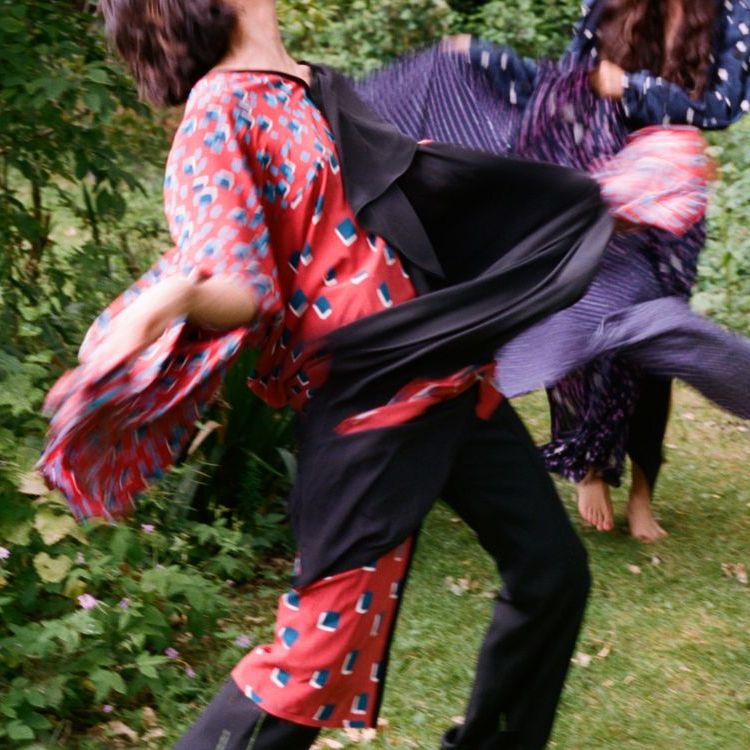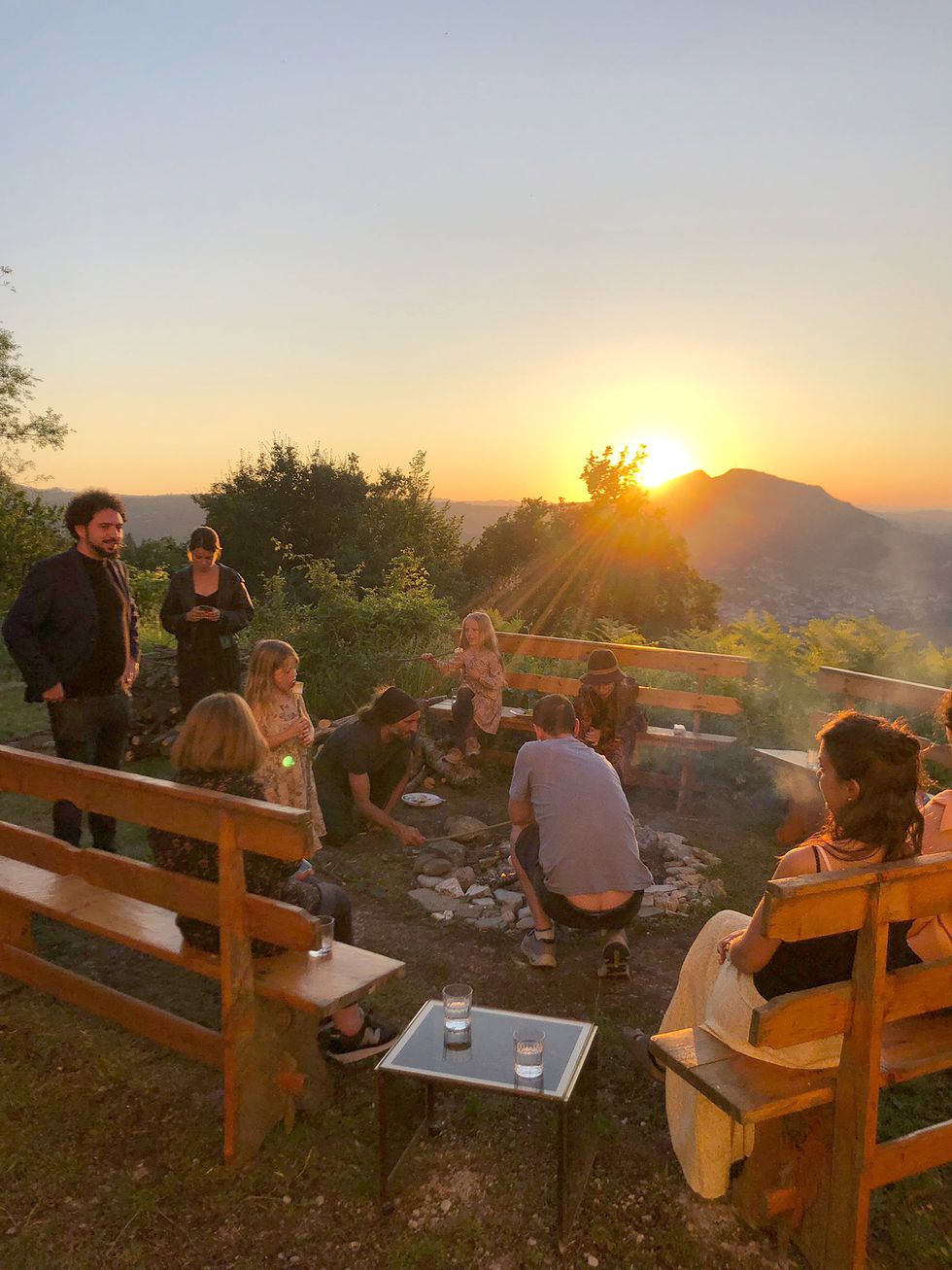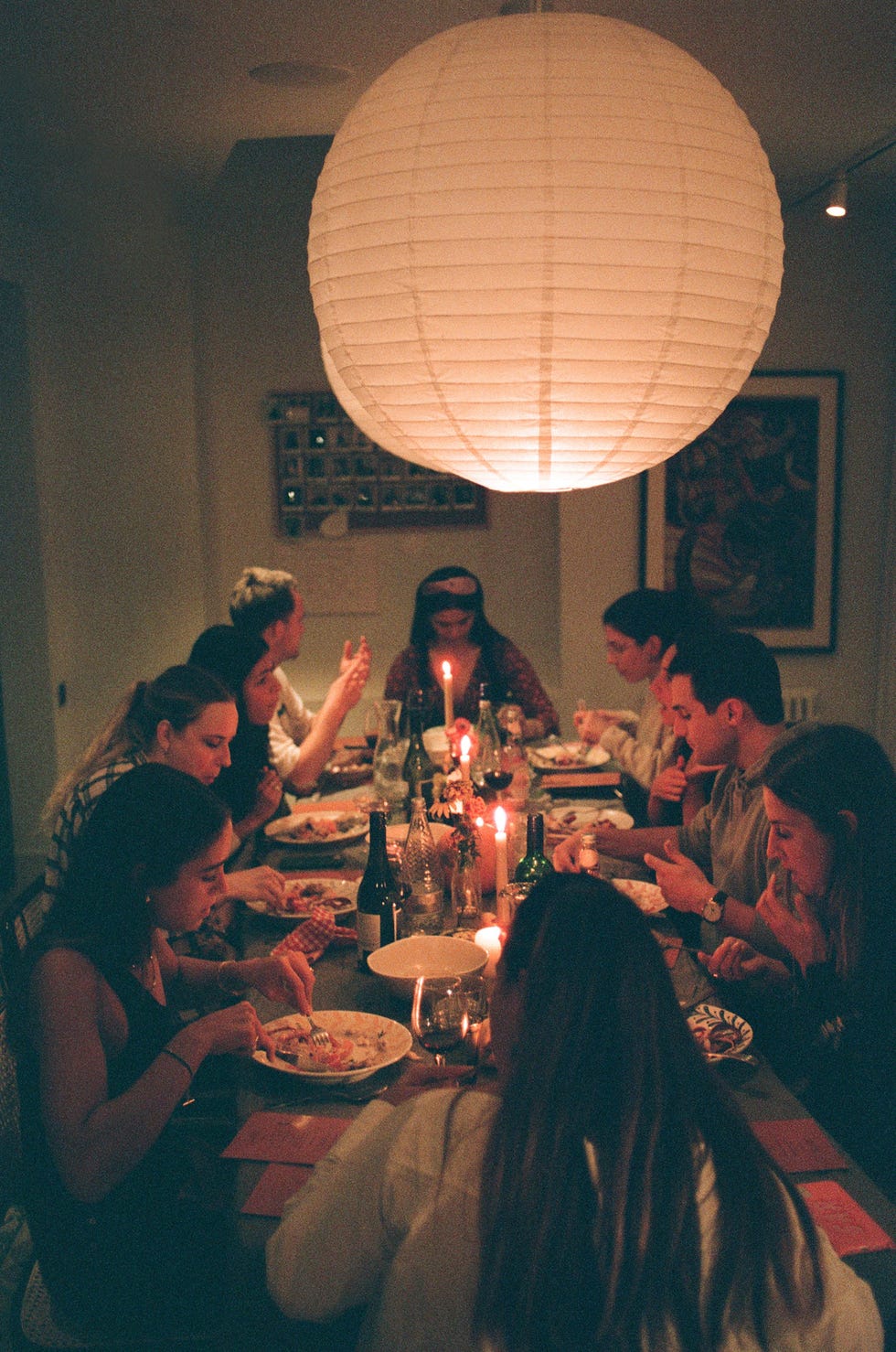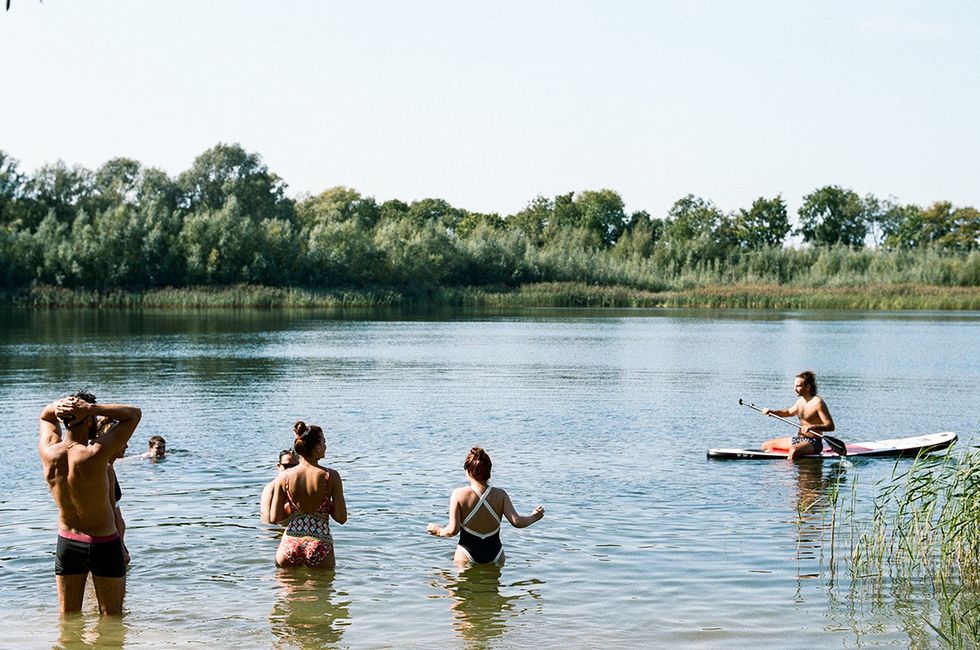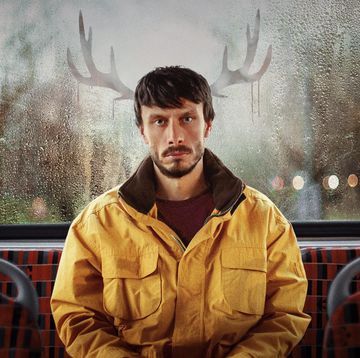I’m sitting around a large oak table in the communal kitchen/living room of Mason & Fifth, a new co-living community in Bermondsey, London. It’s huge, and artfully decorated with stacked prints and coffee table books. Plush sofas in neutral colours create intimate corners within the super-size space. In the kitchen area, I’m joined by seven residents. A private chef brings out bowls of blackened aubergine and hummus, while Fran, a thirty-something astrologer and resident, reads another tenant’s palm.
I’m desperately trying to work out the dynamic. Everyone seems closer than neighbours – but they’re not quite friends.
They live together in this beautiful converted factory, but they’re not really housemates: each person has their own private studio as well as access to the communal areas. Welcome to co-living, billed as an instant community and an end to the anonymity of urban life.
‘I’ve always lived in communal settings,’ says Emily Morrison, a 24-year-old actor who just moved to London, and into Mason & Fifth, from LA. ‘I’m from Australia – my family all lived on the same street. I went to boarding school and lived [on campus] at university, so I wanted to replicate that feeling.’
After dinner, I head upstairs to the studio I’ll be calling home for the next 24 hours. The design is slick and sustain- able – the kitchen counter is made from marble offcuts and the floor from upcycled bamboo. The ensuite bathroom comes with Mason & Fifth-branded toiletries. I appreciate the small touches – a scented candle here, a hanging plant there – but, reader, it is tiny. The bed, despite being ludicrously comfortable, is essentially in the kitchen. And it’s £2,300 a month (the average rent for the borough is £1,850).
FIND OUT MORE ON ELLE COLLECTIVE
Although I finish my stay scoffing at the price per square metre, there’s clearly an appetite for the model. In April, Mason & Fifth will open a second property, intended for shorter stays, in Primrose Hill, and bougie co-living is flourishing across the capital. The Collective, which opened in 2019, is a 705-room development in Canary Wharf offering members an onsite gym and a cinema. It seems the latest luxury in housing isn’t space or parquet flooring: it’s community.
The boom in communal living isn’t just happening across the luxury market. Cohabitation – a concept that involves sharing living spaces with others – has been on the rise across the UK, with the highest growth rate across all living sectors. Fuelled by the UK’s increasing population and lack of affordable-housing options, the number of new co-living developments has more than doubled since the pan- demic. While Mason & Fifth might be the Soho House of the movement, at the other end of the spectrum co-housing can offer a solution for people seeking community-driven homes within their budget. There is even a renewed interest in the self-sufficient communes that pro-liferated in the 1960s and 70s, with a new generation embracing what was once seen as a fringe way of living for hippies and anarchists.
‘A lot of the communities from that period were driven by feminist ideals,’ says Sarah Blandy, a law professor at the University of Sheffield, whose research focuses on collective and individual property rights. ‘Many were against the nuclear family and [the idea of] women being trapped at home doing domestic chores and looking after the children. These communities offered a way around that.’ By the end of the 1970s, the national mood had changed and most had been disbanded, with Thatcherism usher- ing in a new emphasis on self-reliance and home ownership. ‘We moved from a collective idea of society to a much more individualistic view of life in general,’ says Blandy.
Fast-forward a couple of decades, and collectivism is back in vogue. In Vivek Murthy’s 2021 bestseller Together, the former US surgeon general and author writes about the importance of social connection and the hidden impact of loneliness on our mental and physical health. He argues that social-distancing measures introduced during the Covid-19 pandemic ‘condemned us to isolation’, resulting in a collective loneliness. In 2022, 49.63% of adults (25.99 million people) in the UK reported feeling lonely, with more than 3.83 million people (7.1%) experiencing chronic loneliness.
‘We think of the pandemic as a kind of radical break. But, in hindsight, it was really more of a magnifying glass,’ says Benjamin Ramm, a former BBC journalist who set up Honeydew, an ‘eco-commune’ in Maiolo, a mountain village in northern Italy. ‘The loneliness that was already in society was radically magnified: the sense of discontent, the anxiety about modernity and the removal from nature.’
Ramm, who is British-Persian, was in the South of France working as a freelance journalist and consultant when the pandemic hit. ‘I was ostensibly living quite a good life, surrounded by people who had real wealth. That was a perfect example: you can live on a gorgeous coast with complete abundance and still feel deeply unhappy.’
Ramm remembers how, back in 2019, he was splayed out on the floor of a party in the final throes of a psychedelic trip – a profound experience that left him with the desire to find increased connection. When the world went into lockdown a year later, he decided to embark on a radically different way of life. When he learned of a 22-room former hotel for sale, situated on a remote hillside location with panoramic views of the valley, he knew he’d found his new home. ‘Most of it was funded by [selling] my tiny flat in Harringay,’ he says.
Honeydew opened last June and already has 12 to 15 permanent residents, who divide the labour and upkeep of the site and live there rent-free. Short-stay visitors pay £49 a night, while volunteers can come for longer stays and receive food and a room in exchange for services like cooking, farming or cleaning. Honeydew also has a range of scents and ceramics made by residents and sold only on-site.
‘We love hippies, but an encouraging aspect is that the people who have been coming to us are not necessarily who you would have thought would be drawn to a commune,’ Ramm explains. The majority of interest comes from burnt out professionals in their thirties and forties. ‘It’s not just that modernity isn’t working for most people, but you’re pay- ing £2,000 a month [in rent] – for what, exactly?’
Mason & Fifth and Honeydew are drastically different, yet both communities are introducing a new generation to shared living. ‘The co-housing movement has definitely grown in numbers and popularity,’ says Blandy. ‘When I interview younger people, often they disapprove of the way the modern world is so individualised. They want to recreate the kinds of communities we might think we had in the past, where everybody knows each other. For older people, I think it’s about wanting to share more of your life with others, and not face old age alone.’
Taryn Curtis, 46, works for an organisation placing visitors at homestays with organic farmers, and has spent most of her adult life in various forms of co-housing. She lives with her partner at Rainbow, a housing co-op in Milton Keynes. It’s a pedestrianised street of 24 homes, includ- ing a community house used for shared gatherings and meals. ‘It’s a little oasis,’ says Curtis, who was on the waiting-list for four years before moving in last year. As a fully mutual housing co-op, residents control the property and have an equal say in decision-making. Rent is decided according to the cost of managing the housing. For Curtis, who shares a small cottage with her partner, that’s just under £400 a month. ‘We don’t personally own it, but we’ve got security. With the legal set-up of the co-op, you’re both landlord and tenant at the same time.’
Before moving to Milton Keynes, Curtis spent 14 years living at Redfield. Established as an ‘intentional community’ in the 1970s, the old mansion house in north Buckinghamshire, standing in several acres of gardens, is currently shared by 17 adults and several children. ‘Decisions are made through meetings. You’d think people would have similar mindsets but, sometimes, they don’t – contentious things can happen, which is why the rules become very important,’ she says. Still, for Curtis, the benefits justify the bureaucracy. ‘Very few people are driven by the low rents. It’s about others having your back – and being involved in something that’s slightly bigger than you. I think, as a society, we’re prob- ably missing that quite a lot.’
Hundreds of miles away in northern Italy, Ramm echoes Curtis’s emphasis on the sense of purpose that a communal way of life brings. ‘We cannot find real meaning unless we’re part of something larger than ourselves.’ He has already secured a second site in Brazil, in the hills of Teresópolis, 90 minutes from Rio, which will open in April. ‘Honeydew was never meant to be a standalone project. Eco-communities are the future. That old anarchist dream of sharing knowledge and resources was difficult to do in the pre-digital age. Now, with more remote working, the opportunities have hugely increased.
While the prospect of cheap rents, supper clubs and rolling hills is alluring, communal living isn’t always easy. ‘If you’re going to live collectively, like the people doing co-housing or co-ops, it’s a lot of work,’ says Blandy. ‘You’ve got to have meetings and make decisions together. It can be time-consuming.’ What about the Mason & Fifth model – where residents can enjoy shared spaces and elements of collective living, before retre- ating to the privacy of their studios? Blandy is cynical. ‘This has been going on for quite some time, with things like [WeWork’s now-defunct co-living brand] WeLive. It’s described as a community, but I think they’re just jumping on the bandwagon, really. They are commodify- ing what started off as genuine sharing.’
In the midst of the housing crisis, living alone or getting on the property ladder in today’s financial climate is simply not an option available to many. With adults in their mid-thirties to mid-forties three times more likely to be renting their home than 20 years ago, it’s not surprising that the private sector is finding new ways to appeal to generation rent. Mason & Fifth may lack some of the soul that comes from truly collective set-ups, but it is one way of swerving the perils faced by many private renters at the hands of unscrupulous landlords – at least, for those who can afford the monthly bill.
Other developments aim to bridge the gap. In Leeds, Lilac (Low Impact Living Affordable Community) is a sustainable development of 20 houses built around communal spaces, which was created in response to both the cost-of-living and cli- mate crisis. Each member pays 35% of their income, rather than taking out a mortgage – the idea being that it remains affordable for future generations. It’s inspired by the Danish model, where 7% of the population live in some form of co-operatively owned housing. Coincidentally, Denmark is also the second-happiest country in the world, a status that is largely attributed to the high levels of social cohesion.
Could communal living be the answer to the housing crisis? It’s arguably a blueprint we’ll be seeing more of in the future. After all, it takes a village.
ELLE Collective is a new community of fashion, beauty and culture lovers. For access to exclusive content, events, inspiring advice from our Editors and industry experts, as well the opportunity to meet designers, thought-leaders and stylists, become a member today HERE.
